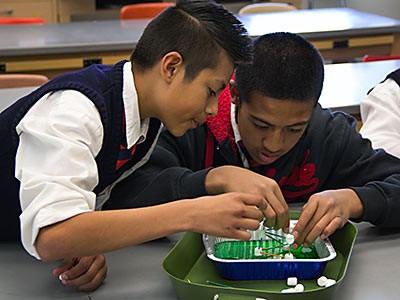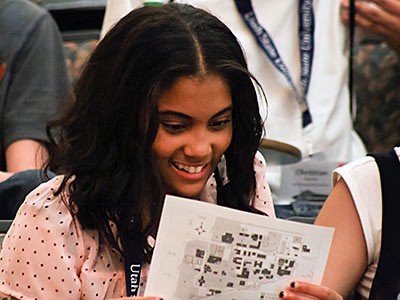USU's GEAR UP Partnership Puts Students on Track to Higher Education
GEAR UP students receive academic support, plus the chance to participate in activities that involve science, technology, engineering and math. (Participants of the 2012 GEAR UP cohort.)
A new, $32.8 million grant will help more than 3,000 Utah middle schoolers catch the vision of higher education — and then make the dream come true.
Half of the funding for the new grant comes from the U.S. Department of Education, and the other half from state and local partners. It supports the USU STARS! GEAR UP Partnership, led by faculty and researchers at Utah State University. The program targets students in schools where more than 50 percent of the student body qualifies for free or reduced lunch, and it supports programming over a seven-year period.
For too many Utah students, college seems unattainable — and even unappealing. Some teens come from families who can’t afford to buy them lunch, or who have to end their education early because of family circumstances.
But the decision to stop with a high school diploma can have strong consequences down the road, both for the student and the state of Utah. A high school graduate can expect an average of 73 percent lower wages than a college graduate. A less-educated workforce means less wealth in the state.
“Our goal is to align the dreams of these students with higher education opportunities,” said James Dorward, a professor in the School of Teacher Education and Leadership who directs the new GEAR UP grant.
The new grant provides programming over seven years through partnerships with eight school districts, two charter schools, three corporations, two USU colleges, the Ute Indian Tribe, USU’s Access and Diversity Center, Hill Air Force Base and the Utah NASA Space Consortium.
The grant’s partners will provide services like academic tutoring and counseling, bring students on visits to corporate and college campuses and give them a chance to see what college life is like and envision themselves taking part.
What’s more, Dorward said they get their hands on activities that will promote their college readiness and get them fired up about learning. Too often, the learning seems like a chore that obscures the real purpose: college and a career.
“It begins to help them see that they’re in school for a reason,” he said.
USU began an earlier, separate GEAR UP program in 2012. Under the leadership of Eric Packenham, an additional 3,000 students have had experiences like participating in teleconferences with other young scientists in Russia, growing radishes from seed that flew in space, attending leadership activities on the USU campus and learning to assemble Greenpower one-person electric vehicles.
While the two GEAR UP programs are separate, they are both benefitting from the years of experience the original program has had.
The effects will extend beyond college for the students who participate directly, Packenham said. They will learn that they can solve big problems. For example, the Greenpower experience puts their hands on low emissions technology — something that could make a big difference to Utah’s air quality.
The project will also help USU researchers gather data on what works and what doesn’t when it comes to helping students succeed in college.
Together, the two USU GEAR UP grants support 6,000 students. At Utah State University, the projects involve five graduate and 40 undergraduate student employees who serve as mentors. Plans are in place to employ more.
Both Packenham and Dorward agree the benefits to the school partners will continue long after the funding ends. The partnerships between schools, communities and corporations will continue. So will after-school tutoring. A pipeline will be in place that feeds students from participating schools to institutions. And students will learn the skills that will help them prepare for careers that have not been invented yet.
“We see them becoming more lifelong learners,” Dorward said.
“Gear Up involves students in highly engaging STEM activities that expand their understanding of potential career options and help students and their families negotiate college and financial aid applications,” said Beth Foley, dean of USU’s Emma Eccles Jones College of Education and Human Services. “These and other services help students, first-generation students in particular, to gain confidence in their own abilities and reach what might otherwise seem like an unattainable goal — to graduate from college and find a fulfilling career.”
“We want to excite students and their teachers about the important work done by engineers,” said College of Engineering Dean Christine Hailey. “Hopefully some of the GEAR UP students will become interested in careers in engineering as they see how critical the work is to improving the quality of their lives and the lives of their family and friends.”
Collaborators include USU’s College of Engineering, the USU Academic Success Center, the Ute Indian Tribe, Texas Instruments, Orbital ATK, RGI Research, Hill Air Force Base and the Utah NASA Space Consortium. School partners include the Davis, Elko, Granite, Logan, North Sanpete, South Sanpete, Tooele and Uintah school districts and the American Preparatory and Dual Immersion academies.
Related links:
USU Emma Eccles Jones College of Education and Human Services
Contact: Dr. James Dorward, jim.dorward@usu.edu
Writer: JoLynne Lyon, 435-797-1463
On-campus visits give GEAR UP participants a taste of college life. (Participants of the 2012 GEAR UP cohort.)
GEAR UP students spent a day at the USU ropes course. (Participants of the 2012 GEAR UP cohort.)
TOPICS
Community 446stories Education 332storiesComments and questions regarding this article may be directed to the contact person listed on this page.










